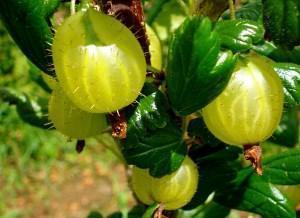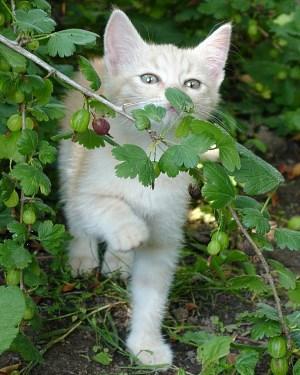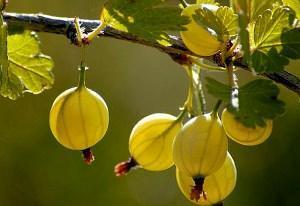Features of growing gooseberries in the country
 Useful properties, excellent taste, high yield and early maturity make this berry shrub competitive. But in order to have a healthy bush and get good yields from it, you need to know how to grow gooseberries correctly.
Useful properties, excellent taste, high yield and early maturity make this berry shrub competitive. But in order to have a healthy bush and get good yields from it, you need to know how to grow gooseberries correctly.
Basic principles of cultivation
There are several rules that are required for every gardener:
- First of all, you need to decide on the gooseberry variety. The survival rate of the bush, its fruiting, and resistance to disease will depend on this.
- It is important to take a responsible approach to choosing a place for planting a plant.
- Choose the exact time for planting the bush.
Gooseberry care and cultivation includes:
- trimming;
- weeding and mulching of the soil;
- timely watering;
- gooseberry fertilization;
- frost protection;
- proper preparation for the winter cold.
Secrets of growing gooseberries in the country
The gooseberry is rightfully considered the favorite of all gardeners. Caring for it does not require a lot of effort and money, and the harvests are always plentiful. Therefore, growing gooseberries in the country is a tradition.
 A place for planting gooseberries.
A place for planting gooseberries.
Before planting a gooseberry bush, you must carefully choose the right place for it. This will depend on the quality of the soil. The plant does not take root well and bears fruit, and is more susceptible to diseases in the ground, which is excessively moist. Therefore, you should avoid crevices and lowlands where water accumulates, darkened areas or areas with heavy clay soil.- Preparing a site for planting gooseberries.
For the successful cultivation of gooseberries on a personal plot, if necessary, you need to improve the quality of the soil by adding humus to it, manure or compost. A sufficient amount of sand is introduced into clay soils at a rate of 1: 2.
Weeds are removed in the selected area, and a hole is dug 40 by 40 centimeters and approximately half a meter deep. Fertilizer is applied: up to a kilogram of compost with wood ash (100g) or a bucket of rotted organic matter. Everything mixes well with the ground, and is filled with water, 3-5 liters.  Landing.
Landing.
In a pit with water (pour about 5 liters right before planting), a seedling is carefully placed 5-6 cm at an angle of 45˚. Its roots, along with moisture, go deep into the soil, adhering tightly to it. This “wet” planting ensures that there are no voids at the roots and the gooseberries will take root quickly. Fill the hole with earth, leaving a trench around the trunk.
If you plan to plant several gooseberry bushes, then the distance between them should not be less than 1.5 meters.- Gooseberry planting time.
How to grow gooseberries correctly? The first thing you need to do is choose a landing time. Autumn is the best time. For example, in mid-October, and in the northern regions it is permissible to plant gooseberries even at the end of September. This gives the bush time to take root before the cold weather, then the acclimatization period falls into the winter period. And in the spring the plant is ready to start growing.
Spring planting of seedlings is permissible. And the best period for this is when the soil begins to thaw, but the buds are not yet swollen.

Gooseberry bush care
There are a number of procedures:
- Loosening and digging up the soil around the trunk of the plant.
- Timely fertilization and watering of gooseberries.
- Bush pruning.
- Disease and pest control.
- Preparing plants for winter.
Tillage
The ground around the perimeter of the crown must be weeded regularly. If the soil on which the gooseberry is planted is "heavy", then it is better to dig it up carefully, since the roots of the plant are located at the surface.
Mulching with humus or peat perfectly replaces these processes. Chopped thin twigs or dry grass can be used as mulch.
Watering and fertilizing gooseberries
Young seedlings need regular and abundant watering. In the future, when growing gooseberries, it is worth watering as needed, depending on the soil and weather conditions.
It is recommended to feed the plant at least 2 times a year: after flowering and after harvesting. For this, one bush will need 80 g. superphosphate, 20 g of potassium chloride (or ½ glass of ash), 40 g of saltpeter and 10 kg. rotted manure. Can be used in spring urea, 30 g at 1m2.
Gooseberry pruning
Sanitary pruning. This is the removal of all dry, diseased or thickening branches. It is held throughout the year.
Formative pruning. It should be done either in early spring or late autumn. The purpose of such pruning is to leave 4-5 branches on the bush, which are most developed. Almost all young shoots are cut out, old shoots are shortened. Those branches that are more than 6 years old are deleted.
Gooseberry diseases and pests
Thanks to the constant development of breeders, modern gooseberry varieties are more resistant to disease. But under some conditions, they are also susceptible to all sorts of diseases, and the first danger for the bushes is powdery mildew.
What unfavorable factors are dangerous for the plant:
- Lack of care;
- Long-term humidity;
- Cool weather.
How to take care of his health?
Good drainage or regular weeding will help drain excess moisture. If you know about the approach of frost, you can water the bush in advance or insulate it with a special material (the film must be removed during the day).
The gooseberry's first enemy is powdery mildew, but rot, mottling, and anthracnose also threaten the plant. Plants should be abundantly sprayed after leaf fall in autumn, or in spring before bud break with iron sulfate (3 g per 1 liter of water). These are both preventive measures and treatment at the first detection of signs of the disease.
Ash infusion is effective against aphids and other pests (1 kg per 3 liters of water). In early spring and after flowering, the bush is treated as a preventive measure.
Diseases affect the yield of the plant, so it is important to monitor the condition of the bush, and respond in time to all its needs.
Protecting gooseberries from cold weather
The gooseberry is unpretentious, and under the snow that has fallen, its roots will feel quite protected. But gardeners recommend not to forget to treat the bush with means that will help the plant not get sick and give an excellent harvest.
- The first thing to do after harvesting and falling leaves is to collect all the plant debris from under the bush. Then it is worth treating the gooseberries with 1% Bordeaux liquid, thoroughly sprinkling it.
- The next step is to dig up the ground near the trunk to prevent the insects from overwintering.
- Now you need to fertilize the plant.

Growing gooseberries in different climates
 When choosing a gooseberry variety, you need to take into account the climatic conditions under which it will grow. And accordingly, take care of the plant, depending on the air temperature, the nature and amount of average annual precipitation, and other features of the weather conditions in a particular area.
When choosing a gooseberry variety, you need to take into account the climatic conditions under which it will grow. And accordingly, take care of the plant, depending on the air temperature, the nature and amount of average annual precipitation, and other features of the weather conditions in a particular area.
For example, especially the cultivation of gooseberries in Siberia includes additional measures to prepare for the winter.
The bush, in addition to being covered with earth or sawdust at the base, forming a mound, is also covered with agrospan. This is if the hard frosts came before the snow.
In the case when the snow has already fallen, you can gently bent the gooseberry bush to the ground, fixing it with boards, and cover it with snow. In this case, the gooseberry winters well even in especially cold regions of the country.
Some gooseberry varieties can even do without additional cover. These include "Houghton", "Red Large" and others.
For the successful cultivation of gooseberries in the Moscow region, you need to take a responsible approach to the selection of suitable varieties. What are the requirements for them:
- Powdery mildew resistant;
- Early and medium ripening varieties are best;
- Those that have already proven themselves as suitable for growing in central Russia. So, for example, "Reliable", "Malachite", "Rodnik", "Plum" and many others.
Features of growing gooseberries from seeds
 For many gardeners, it is not difficult to grow gooseberries from seedlings. But there are other ways, for example, by seeds or layering.
For many gardeners, it is not difficult to grow gooseberries from seedlings. But there are other ways, for example, by seeds or layering.
Here are some secrets of growing gooseberries from seed:
- It is necessary to collect seeds from ripe berries and wash them from the pulp, dry them.
- Do not store the seeds, but after they dry out, sow immediately.
- Drainage must be laid at the bottom of the pots.
- The soil should contain in equal proportions an earthen fertile mixture from the garden, humus mixture and sand.
- Sow to a depth of 0.5 cm, every 5 cm.
- Pour over and cover with foil, and put the pots in a room with a temperature of 3-5 ° C.
- Do not allow the soil to dry out.
In mid-spring, the pots are taken out into the garden and buried. Grown seedlings dive when 2 true leaves appear on them. The land where they are planted should be well fertilized: 10 kg per square meter. fermented manure, and the same amount of humus. In the future, the soil should be regularly loosened, watered and fertilized young gooseberry seedlings.

Tell me which variety is better to choose for planting in the middle zone (frosts down to -30). My soil is clayey. thank